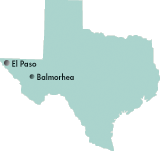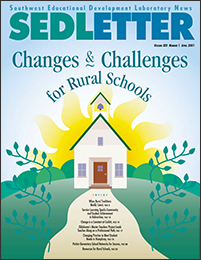Service Learning Sparks Community and Student Achievement in Balmorhea
 | |
| Balmorhea principal Michael Barrandey and students enjoy the West Texas sunshine. | |
It may seem surprising to find an innovative school in the Chihuahuan desert of far West Texas, especially in a town of only 855. But the residents of Balmorhea have found innovative ways to improve their community and their children's education. Struggling communities don't need miracles to succeed, according to Balmorhea principal Michael Barrandey. "You just have to think out of the box," he says.
The Balmorhea Independent School District serves 230 students in grades K-12, who all attend Balmorhea School. The district is poor, as are the majority of its students—approximately 71 percent of students qualify for free or reduced lunch. The largest employers in the area are the school district, the highway department, a rock crushing plant, and the state prisons in Pecos and Fort Stockton (38 and 52 miles away, respectively). Many Balmorhea residents depend on farming and ranching for their livelihoods. In recent years, a struggling economy has plagued this community—the average weekly wage hovers just above $300. Teachers in the district earn the state base pay of $22,700 per year, making it difficult for Balmorhea ISD to compete with larger districts in the area, such as Odessa, which pays its starting teachers approximately $32,000 per year. Odessa, the nearest town of any size (population 95,700), is 110 miles northeast of Balmorhea on Interstate 20. "We're a poor district," says Barrandey. "We don't have tons of money like some schools. . . we have to do the best we can with what we've got."
It's the People Who Make a Difference
 | |
Although the district is financially poor, Barrandey, who has worked in the district since 1978, cites a wealth of people in the community who care about the school district and the town. Despite the low teacher salaries, the district has a teacher turnover rate that "is almost nothing," he reports. Of the school's 25 teachers, 10 of them are "homegrown." Due to the small number of students in the district, administrators and teachers know their students well and are able to provide personalized attention.
"We pretty well know exactly what each kid is doing, what they're not doing, if they're going to tutorial, if they're not. We know if they're supposed to leave campus or not, those kinds of things," Barrandey says. "We know about their home lives. If they have any problems they'll come talk to us . . . you do a little bit of counseling, a little bit of teaching, a little bit of everything."
The teachers at Balmorhea make all the difference, notes Amy Averett, a program specialist with SEDL's National Center for Family and Community Connections with Schools. Averett worked with the Balmorhea schools during the past two years through SEDL's Rural Development Collaborative Action Team project.
"There's a core group of teachers at Balmorhea who are interested in integrating the curriculum with real-life experiences that connect the students to their community," she says. The sense of community now so prevalent has not always existed in Balmorhea, however.
"In 1993, Balmorhea was a community where people wanted to make positive changes in the school and community, but they were each working in isolation," Barrandey observes. "Their intentions were good and they really did some things for the community, but eventually people just got tired. The same ones were doing things over and over. . . . they were just worn out."
That lack of community involvement may have been reflected, in part, in the low standardized test scores among its students. In 1994, only 25 percent of Balmorhea students passed the state-mandated Texas Assessment of Academic Skills (TAAS) examination.
"We were on the rock bottom," Barrandey admits.
Service Learning Comes to the Rescue
That same year, Barrandey attended a three-day workshop on service learning, which is a way for students to learn through community service activities that are aimed at meeting critical community needs. The workshop Barrandey attended led to a $5,000 service-learning grant that was used to start several service learning projects: the district's concrete tennis courts were repaired, an EMS training project undertaken, and trees were planted in a run-down community park and throughout the town. It was the spark that ignited a wildfire of community service in Balmorhea. "Things kind of started taking off from there," Barrandey explains. "All of a sudden the city took it on itself to do some beautification downtown. Then the state came in and built walkways and curbs down the middle of town . . . As a result of that, other little projects have come up and people are getting involved."
 |  |
 | |
| Top left: Students work on the construction of a ramp on campus. Top right: Downtown Balmorhea. Water from San Solomon Springs brought settlers to the area in the early 1900s. Bottom right: Principal Michael Barrandey chats with agriculture science teacher Bob Bagley in the school's shop area. | |
Quality of Life Improves for Balmorhea
Balmorhea's first service learning initiative led to the founding of numerous community service projects, including a school-based community health clinic, operated in cooperation with the Texas Tech Health Science Center. This is the town's only medical facility. A doctor from Odessa sees between 15-20 patients each time he comes to the clinic. In addition to the doctor, the school nurse and students staff the clinic. Students check blood pressure and vital signs and do administrative work.
Business education teacher Yolanda Hernandez and school nurse Carol Hoffmeyer spearheaded the effort to establish the clinic. Like any good service learning project, students were involved in a variety of activities linked to their classroom curriculum. Hernandez's business students not only learned about medical procedures from Hoffmeyer, they procured grant applications, drafted business and medical plans, established objectives, discussed topics like business ethics and confidentiality, and became CPR certified. They also focused on learning about human relations by role-playing a variety of situations that could arise when the clinic was opened. Accounting students help set up the financial operations for the clinic and three male interior design students sewed colorful clinic gowns in a variety of sizes.
"It was a good opportunity for us," says Barrandey. "We didn't have any medical facility before we opened the clinic. The closest doctor was 38 miles away in Pecos. The problem is keeping a doctor interested in coming to a small community,"
 |  |
 | |
| Top left: LPN Hilda Rodriguez stands in one of the clinic‘s examination rooms. Top right: Business teacher Yolanda Hernandez was instrumental in getting the community health clinic up and running. Bottom left: Wiring is the task of the day in the school's technology class | |
The district took another step to ensure the health of its students in September 2000 by providing free breakfast and lunch for every student. Funded by the federal government, Barrandey says he thinks the program has helped students perform better in the classroom.
"The experts say that kids that are fed in the morning think better, think more clearly, and are more attentive," he says. "I remember seeing a lot of kids with their heads down in class because they were sleepy. I don't see that anymore."
The school has also implemented an Adult Health Program, which allows adults in the community to use school facilities two nights a week. They can play basketball, lift weights, run, jog, or use the whirlpool. This provides a needed service to the town, since there is no exercise facility in Balmorhea. "We want people to understand that this is their school," Barrandey says.
Students Prepare for a Competitive Workforce
To give its students an edge in the information economy, Balmorhea built a technology program that the principal considers "a leader" in West Texas. Funded by two Texas technology grants, the program allows the district to have a 1.3-to-1 computer-student ratio. Each student has access to the Internet and an email account, with safeguards in place to protect students from improper material.
The district has entered into a partnership with Cisco Systems to provide a two-year program to certify high school students as Cisco technicians. Students learn how to assemble computers, install memory, wire buildings for networks, and set up hubs. Two students who graduated from the program last year now earn $34,000 a year as computer technicians in Honduras. In a few years, they can expect an annual salary of $70,000, Barrandey says.
The school also benefits from students being trained in computer technology. Students do a lot of the technology work within the district, although the district is fortunate enough to have one full-time technology expert on staff.

Like many small school districts, Balmorhea is limited by the number of courses the high school can offer. The high school has arranged a distance-learning agreement with Sul Ross State University, Midland College, and Odessa College. Students can earn college credit while they are earning credits toward their high school diploma. Balmorhea is also working with Odessa High School to provide its students with higher-level coursework it cannot offer, such as trigonometry.
In a small town, many students never think about going to college. Many have never left Balmorhea. That is slowly changing, thanks in part to Upward Bound, a program to introduce high school students to a college campus and encourage them to attend college. The school is now in its second year of Upward Bound.
"The thinking has shifted," Barrandey observes. "The students are looking at ways they can do some things. The program has changed their perspective as far as what life has to offer."
Student Achievement Rises
Barrandey says that seeing his students succeed in "the real world" lets him know that the district is doing its job, despite what test scores might say. "The definition of an effective school is a school that has high test scores," he explains. "A successful school is a school where students are successful all the way around."
 | |
| Balmorhea teachers and administrators provide students with a variety of real-world activities linked to the curriculum. The district has a partnership with Cisco Systems to provide a two-year program where students can be certified as Cisco technicians. | |
Balmorhea is ranked by the Texas Education Agency as an "academically acceptable" district. TEA rankings are based largely on TAAS scores, but other factors such as attendance and drop-out rates are taken into account. Schools and school districts may be ranked as low-performing, acceptable, recognized, or exemplary.
"We're working hard to get to recognized and exemplary status," notes the Balmorhea principal. "We've made some gains. You have to take into account the fact that we are a small school in a rural community with low socioeconomics and at-risk factors. We will continue to work towards higher scores, but the success of our kids is evident in the real-world applications."
Since implementing service learning, Balmorhea's test scores have been on the rise. By the end of 1994, 50 percent of Balmorhea students had passed the TAAS. In 1995, that number increased to slightly more than 70 percent. In 2001, 78 percent of the district's students passed the test. Barrandey expects that number to steadily rise.
"The idea of service learning has impacted test scores indirectly," he says. "It has instilled pride in the kids, which has filtered out into the community."
Averett says of the eight rural school sites she has worked with, Balmorhea is one of her favorites. "Balmorhea is far and away the most innovative rural community that I have come across," she says. "The school has looked very closely to see what kind of needs the community has and has tried to meet those needs."
John V. Pennington is a freelance writer who lives in Hot Springs, Arkansas.
Next Article: Change Is a Constant at Cochiti

